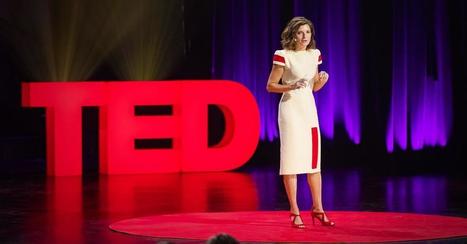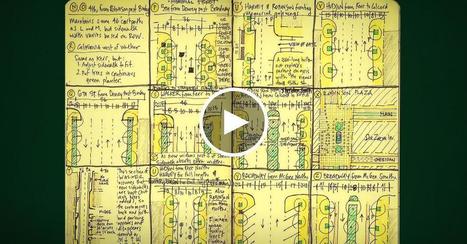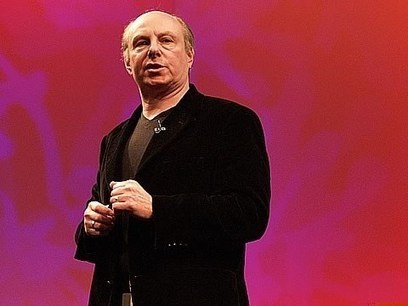"There are about 7,000 languages spoken around the world -- and they all have different sounds, vocabularies and structures. But do they shape the way we think? Cognitive scientist Lera Boroditsky shares examples of language -- from an Aboriginal community in Australia that uses cardinal directions instead of left and right to the multiple words for blue in Russian -- that suggest the answer is a resounding yes. 'The beauty of linguistic diversity is that it reveals to us just how ingenious and how flexible the human mind is,' Broditsky says. Human minds have invented not one cognitive universe, but 7,000."
Get Started for FREE
Sign up with Facebook Sign up with X
I don't have a Facebook or a X account
 Your new post is loading... Your new post is loading...
 Your new post is loading... Your new post is loading...

GTANSW & ACT's curator insight,
August 31, 2017 8:01 PM
Enhancing urban liveability - creating better cities for the future
Zeke Robinson's curator insight,
May 26, 2015 9:23 PM
i disagree with this guy, for suburbs bring us close and save space and its good that we have them.
Alyssa Dorr's curator insight,
December 16, 2014 6:39 PM
I had not heard of Alexander Von Humbboldt before watching this video. He is said to be one of the most amazing scientists to ever live. More places around the world have been named after him than any other person. His name was lost in history so this is why many people are not familiar with him. He started off as a geologist, then he began a scientific five year journey from 1799-1804. His journey was long, dangerous at some times, and very interesting to hear about. He travel through mountains, across oceans, and through villages. For one thing, he was the first explorer to witness preparation of the curare plant, which was used for poison arrows. He recognized the importance of the cinchona tree, who's bark contains quinine, a malaria killer. He also discovered the ocean current which eliminates rainfall on the coast of Peru. To record air pressure, he climbed to the top of one of the tallest volcanoes, Mount Chimborazo. His total journey consisted of about 2400 miles, which is reality is equal to the circumference of the Earth. 
Danielle Lip's curator insight,
February 10, 2015 8:42 PM
This video was quite interesting because I had never heard of Alexander von Humboldt, yet this great scientist founded many different important facts that are beneficial and helped to find with the preparation of the Curare Plant which is in poisonous arrows and discovered the ocean current on South America. Without Humboldt South America might have been at a lose for some objects and geographical information. Everyone has an impact in geography and geology, yet Humboldt helped to create contour maps which happened different patterns, everyone builds off of others ideas. 
Kristin Mandsager San Bento's curator insight,
March 5, 2015 3:58 PM
Nope, never heard of him. Humboldt did some extraordinary things though. I'm surprised we don't hear more about him in education. I've definitely heard of Darwin though. It's interesting what we decide is relevant or who is relevant in history.

Amanda Morgan's curator insight,
September 18, 2014 10:51 AM
Great video! Very cool to see how far the world has come in regards to globalization. Technology has allowed the people across the globe to immerse themselves in other cultures and good from other parts of the world.

Woodstock School's curator insight,
June 4, 2014 6:05 AM
A good teaching tool for explaining the diversity of languages. 
Chris Plummer's curator insight,
January 11, 2015 11:46 PM
Summary- This video explains how so many languages came to be and why. By the early existence of human there was a such smaller variety of languages. Tribes that spoke one language would often split in search of new recourses. Searching tribe would develop in many new different ways than the original tribe. new foods, land, and other elements created a radically different language than the original.
Insight- In unit 3 we study language as a big element of out chapter. One key question in chapter 6 was why are languages distributed the way they are. It is obvious from the video that languages are distributed they way they are is because of the breaking up from people which forced people to develop differently thus creating a different language. As this process continues, there become more and more branches of a language family. |

Shelby Porter's curator insight,
November 4, 2013 10:39 AM
It isn't surprising that the more a country has developed, the more wasteful they are. I just think that we need to change this standard. We can not keep this up if we want to sustain ourselves for centuries to come. If we are going to change our consumption culture, we need to look at why it has become the way it is. Why do we see food as unappealing? This is an interesting video and certaintly makes you think twice about throwing anything away. 
Kenny Dominguez's curator insight,
November 29, 2013 6:13 PM
Ted explains it well how we all waste perfectly good food that people would like to eat. Also it was amazing how much food was in the dumpsters that was just a day or week old. That meat could feed hundreds of people that are struggling to eat and all that meet to waste. 
megan b clement's curator insight,
December 16, 2013 1:51 AM
Ted talks about just how wasteful our planet is. How we just ignore the issue and act like it will not affect us in the future. When he shows you video and pictures of massive piles of the ends of a loaf of bread or all the food that Stop and Shop throws out because it does not "look" good for the customer. How every little bit of help counts you can try to make a little bit of an effort to be less wasteful. We have so much unnecessary waste. Like when he uses the example of how many people throw away the ends of a loaf of bread then he shows the waste of the ends of bread in massive piles it makes you sick. Especially with all of the hungry people in the world we need to be more resourceful.
Deanna Metz's curator insight,
March 1, 2016 8:04 PM
It is never a bad time to hear from Hans Rosling. In this TED talk he shares data that shows how popular myths about the less developed world (especially fertility rates and life expectancy) have radically changed in the last 40 years. Tags: gapminder, development, TED.

Built 4 Betterness Ed van den Berg's curator insight,
December 14, 2014 3:17 PM
Not surprisingly the DNA of cities is a follow-up of human DNA and understanding this will explain and predict how the body of a city will develop!
SRA's curator insight,
April 16, 2015 2:10 AM
The idea that cities are just organisms that are satisfying the laws of biology is interesting. Especially because Physicist Geoffrey West brings the idea of Scalability which by definition is, the ability of a system, network, or process to handle a growing amount of work in a capable manner or its ability to be enlarged to accommodate that growth. What’s mind blowing to me is that the system that is referred to here is human interaction. We create these cities through our interaction and experience. With a growth rate of 1,000,000 people every year the math adds up to an agreeable 15% rise in income levels, patents, and super creative people every year which is undoubted a win for civilization and society. But with that we must keep in mind also this means a 15% increase in things like deadly disease, crime, poverty, and ecological issues leading to further degradation of our planet. This unbounded growth means the system is destined to collapse. The math behind cities doesn't lie if we don’t prepare cities have a fate to die like every other organism in Biology. So it is up to us to create and innovate to sustain this growth and avoid the collapse. But we must do so at a forever increasing pace. Which subsequently is also part of another system predetermined to collapse. What I mean is what happens when we cannot innovate fast enough to sustain this growth? - Caleb Beckett
BrianCaldwell7's curator insight,
April 5, 2016 8:14 AM
While corporations rise and fall, it is quite rare for a city to entirely fail as an economic system. Huge cities have some negative consequences, but the networks that operate in the city function more efficiently on economies of scale in a way that offsets the negatives. Increasing a city's population will continue to improve the economies of scale (larger cities have higher wages per capita, more creative employment per capita, etc.). However, this growth requires major technological innovations to sustain long-term growth.
Tags: urban, planning, megacities, industry, economic, scale, TED, video.

Courtney Barrowman's curator insight,
May 21, 2015 4:06 PM
unit 6 key concepts: industrialization, development, technology 
Ryan Tibari's curator insight,
May 27, 2015 10:23 AM
Washing machine, the greatest invention of the industrial revolution. Hans Rosling further proves this point, highlighting many aspects of how industrialization not only changed the economy, but the people.
mary jane james's curator insight,
April 7, 2017 2:55 PM
This video relates to my subject on religion by showing the five main religions and how they're changing the world and prospective of how people see themselves on earth.
My opinion on the video is that is good to see that all of the religions are somewhat related by where and how they were created, and also what is shown in them.
Hailey Austin's curator insight,
May 11, 2017 9:53 PM
This article relates to are class because it is talking about different religions. It states that we all have different beliefs, but we believe in a higher power. This article was interesting because it shows you how different your beliefs are to other religions. They all have a story they believe is true.

CT Blake's curator insight,
August 29, 2014 8:03 PM
For use in understanding the placement of businesses in Human Geography. 
Luke Walker's curator insight,
October 3, 2014 3:34 AM
A great video lesson that gets at the heart of location theory and competition.

Mirta Liliana Filgueira's curator insight,
June 5, 2014 2:37 PM
La urbanización Y EVOLUCIÓN De Las Ciudades.
Jessica Rieman's curator insight,
February 11, 2014 2:03 PM
Plate tectonics have alot to do with the world and how the world will evolve and in which way it will tranform in specific places. Pangaea involves not only Africa but also South America and how they broke away from the rest of the contenents about 200 million years ago. This idea involves the reality that the continents never stop shifting and the top two layer's of the Earth still grow at the rate of our finger nails grow. Divergent and Convergent boundries are apparent in the Earths ability to shift and eith come together or dive apart. 
Maria la del Varrio's curator insight,
November 26, 2014 4:55 PM
Very interesting that the earth has changed and continues to change. The continents have been separated over time and the example is there as Michael Molina explains that the continents of Africa and South America were once united as they have found remains of dinosaurs in eastern South America and West Africa.
April Howard's curator insight,
February 13, 2015 1:36 PM
Visual Explanation of Pangaea and Plate Tectonics |


























This talk corresponds to the second half of Unit 3 - Culture.